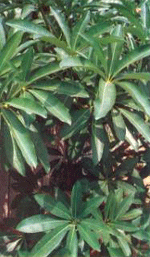| PlantID | 0124 |
| Botanical Name | Terminalia arjuna |
| Common Name | Arjun Myrobalan |
| Classification | | Kingdom: | Plantae | | Subkingdom: | Tracheobionta | | Division: | Magnoliophyta | | Class: | Magnoliopsida | | Subclass: | Rosidae | | Order: | Myrtales | | Family: | Combretaceae | | Genus: | Terminalia | | Species: | arjuna |
|
| Part used | Fruits, leaves and bark. |
| Medicinal Properties | Fruits: deobstruent and tonic; Bark: astringent, antidysenteric, antipyretic, cardiotonic, lithotriptic, styptic and tonic.
|
| Medicinal Use | It cures ulcer, relieves from fatigue and allays thirst. Leaves: juice used in earache, externally used as a cover on sores and ulcers; Fruits: used as tonic. Bark: useful in fractures, ulcers, urethrorrhea, leucorrhoea, diabetes, cardiopathy, anaemia, cirrhosis of the liver and hypertension. According to Ayurved, it also very useful in sexually transmitted diseases such as gonorrhea.
|
| Chemistry | Arjunolic acid and its saponin, beta-sitosterol, ellagic acid. Fruits: arjunone and tannin; Leaves: Alicyclic and amino acids and polyols. Bark: arjunine, lactone, arjunetin, friedelin, arjunic acid, arjunglucosides I and II, large quantities of calcium salts and traces of aluminium and magnesium salts.
|
| Cultivation | NA |
| Regional Habitat | Throughout Rajasthan, common on the banks of rivers and streams. Also planted for shade or ornament in avenues or parks. |
| Description | Evergreen large tree, grows up to 20-25 meters in height. It Shedds its skin in time to time. Bark is smooth and grey. Leaves: simple, subopposite, coriaceous, oblong or elliptic, hard, 10-20 cm long. Flowers: yellowish-white, borne in shortly panicled-spikes. Fruits: 2.5-5 cm long, obovoid-oblong, with 5-7 equal, hard, coriaceous, thick narrow wings. Flowers in March-June months and fruits in September-November.
|
| Image |  |


